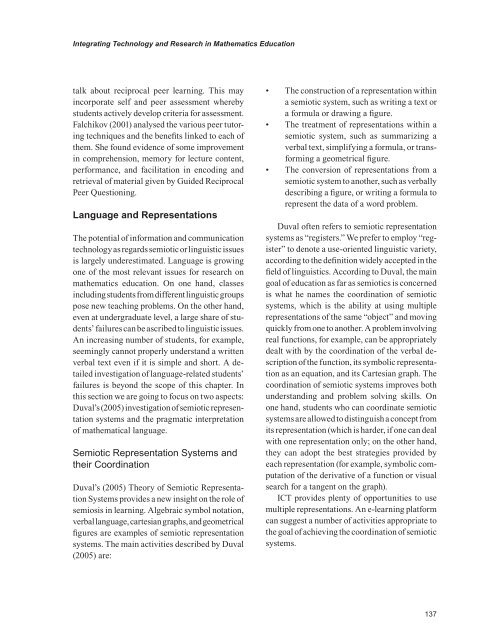Advances in E-learning-Experiences and Methodologies
Create successful ePaper yourself
Turn your PDF publications into a flip-book with our unique Google optimized e-Paper software.
Integrat<strong>in</strong>g Technology <strong>and</strong> Research <strong>in</strong> Mathematics Education<br />
talk about reciprocal peer learn<strong>in</strong>g. This may<br />
<strong>in</strong>corporate self <strong>and</strong> peer assessment whereby<br />
students actively develop criteria for assessment.<br />
Falchikov (2001) analysed the various peer tutor<strong>in</strong>g<br />
techniques <strong>and</strong> the benefits l<strong>in</strong>ked to each of<br />
them. She found evidence of some improvement<br />
<strong>in</strong> comprehension, memory for lecture content,<br />
performance, <strong>and</strong> facilitation <strong>in</strong> encod<strong>in</strong>g <strong>and</strong><br />
retrieval of material given by Guided Reciprocal<br />
Peer Question<strong>in</strong>g.<br />
Language <strong>and</strong> representations<br />
The potential of <strong>in</strong>formation <strong>and</strong> communication<br />
technology as regards semiotic or l<strong>in</strong>guistic issues<br />
is largely underestimated. Language is grow<strong>in</strong>g<br />
one of the most relevant issues for research on<br />
mathematics education. On one h<strong>and</strong>, classes<br />
<strong>in</strong>clud<strong>in</strong>g students from different l<strong>in</strong>guistic groups<br />
pose new teach<strong>in</strong>g problems. On the other h<strong>and</strong>,<br />
even at undergraduate level, a large share of students’<br />
failures can be ascribed to l<strong>in</strong>guistic issues.<br />
An <strong>in</strong>creas<strong>in</strong>g number of students, for example,<br />
seem<strong>in</strong>gly cannot properly underst<strong>and</strong> a written<br />
verbal text even if it is simple <strong>and</strong> short. A detailed<br />
<strong>in</strong>vestigation of language-related students’<br />
failures is beyond the scope of this chapter. In<br />
this section we are go<strong>in</strong>g to focus on two aspects:<br />
Duval’s (2005) <strong>in</strong>vestigation of semiotic representation<br />
systems <strong>and</strong> the pragmatic <strong>in</strong>terpretation<br />
of mathematical language.<br />
Semiotic Representation Systems <strong>and</strong><br />
their Coord<strong>in</strong>ation<br />
Duval’s (2005) Theory of Semiotic Representation<br />
Systems provides a new <strong>in</strong>sight on the role of<br />
semiosis <strong>in</strong> learn<strong>in</strong>g. Algebraic symbol notation,<br />
verbal language, cartesian graphs, <strong>and</strong> geometrical<br />
figures are examples of semiotic representation<br />
systems. The ma<strong>in</strong> activities described by Duval<br />
(2005) are:<br />
• The construction of a representation with<strong>in</strong><br />
a semiotic system, such as writ<strong>in</strong>g a text or<br />
a formula or draw<strong>in</strong>g a figure.<br />
• The treatment of representations with<strong>in</strong> a<br />
semiotic system, such as summariz<strong>in</strong>g a<br />
verbal text, simplify<strong>in</strong>g a formula, or transform<strong>in</strong>g<br />
a geometrical figure.<br />
• The conversion of representations from a<br />
semiotic system to another, such as verbally<br />
describ<strong>in</strong>g a figure, or writ<strong>in</strong>g a formula to<br />
represent the data of a word problem.<br />
Duval often refers to semiotic representation<br />
systems as “registers.” We prefer to employ “register”<br />
to denote a use-oriented l<strong>in</strong>guistic variety,<br />
accord<strong>in</strong>g to the def<strong>in</strong>ition widely accepted <strong>in</strong> the<br />
field of l<strong>in</strong>guistics. Accord<strong>in</strong>g to Duval, the ma<strong>in</strong><br />
goal of education as far as semiotics is concerned<br />
is what he names the coord<strong>in</strong>ation of semiotic<br />
systems, which is the ability at us<strong>in</strong>g multiple<br />
representations of the same “object” <strong>and</strong> mov<strong>in</strong>g<br />
quickly from one to another. A problem <strong>in</strong>volv<strong>in</strong>g<br />
real functions, for example, can be appropriately<br />
dealt with by the coord<strong>in</strong>ation of the verbal description<br />
of the function, its symbolic representation<br />
as an equation, <strong>and</strong> its Cartesian graph. The<br />
coord<strong>in</strong>ation of semiotic systems improves both<br />
underst<strong>and</strong><strong>in</strong>g <strong>and</strong> problem solv<strong>in</strong>g skills. On<br />
one h<strong>and</strong>, students who can coord<strong>in</strong>ate semiotic<br />
systems are allowed to dist<strong>in</strong>guish a concept from<br />
its representation (which is harder, if one can deal<br />
with one representation only; on the other h<strong>and</strong>,<br />
they can adopt the best strategies provided by<br />
each representation (for example, symbolic computation<br />
of the derivative of a function or visual<br />
search for a tangent on the graph).<br />
ICT provides plenty of opportunities to use<br />
multiple representations. An e-learn<strong>in</strong>g platform<br />
can suggest a number of activities appropriate to<br />
the goal of achiev<strong>in</strong>g the coord<strong>in</strong>ation of semiotic<br />
systems.


